Innovation and Commercialization Strategies: Brainlab Report
VerifiedAdded on 2020/07/23
|12
|4093
|79
Report
AI Summary
This report provides a comprehensive analysis of innovation strategies within Brainlab, a medical technology company. It explores the importance of innovation, differentiating it from invention, and examines how organizational vision, culture, and teamwork shape commercialization. The report delves into the 4Ps of innovation, the use of innovation funnels, and the development of frugal innovation within a business context. It further discusses the commercial funnel, new product development, and the creation of an innovative business case. Finally, the report evaluates tools for developing, retaining, and protecting intellectual property, offering valuable insights into Brainlab's approach to innovation and business development.
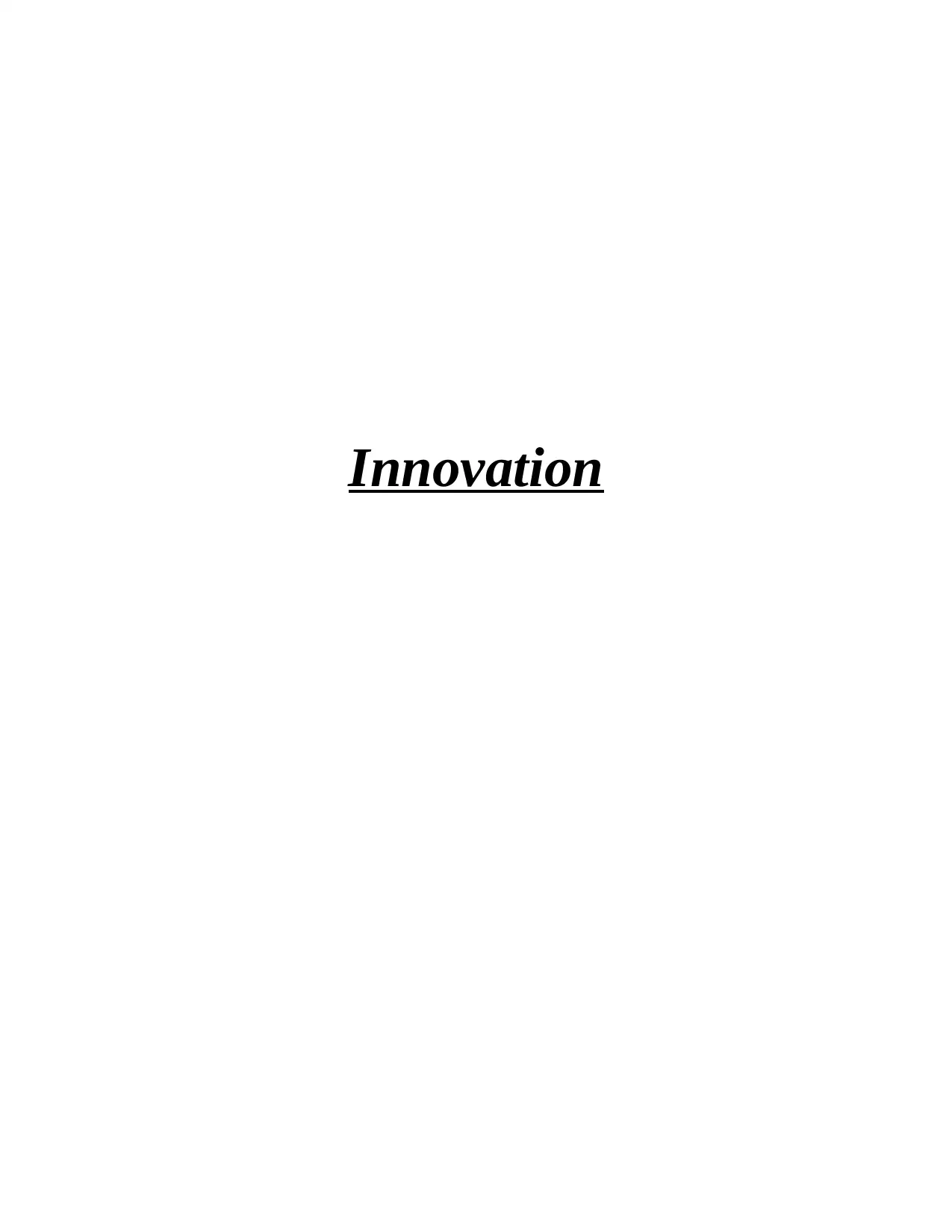
Innovation
Paraphrase This Document
Need a fresh take? Get an instant paraphrase of this document with our AI Paraphraser
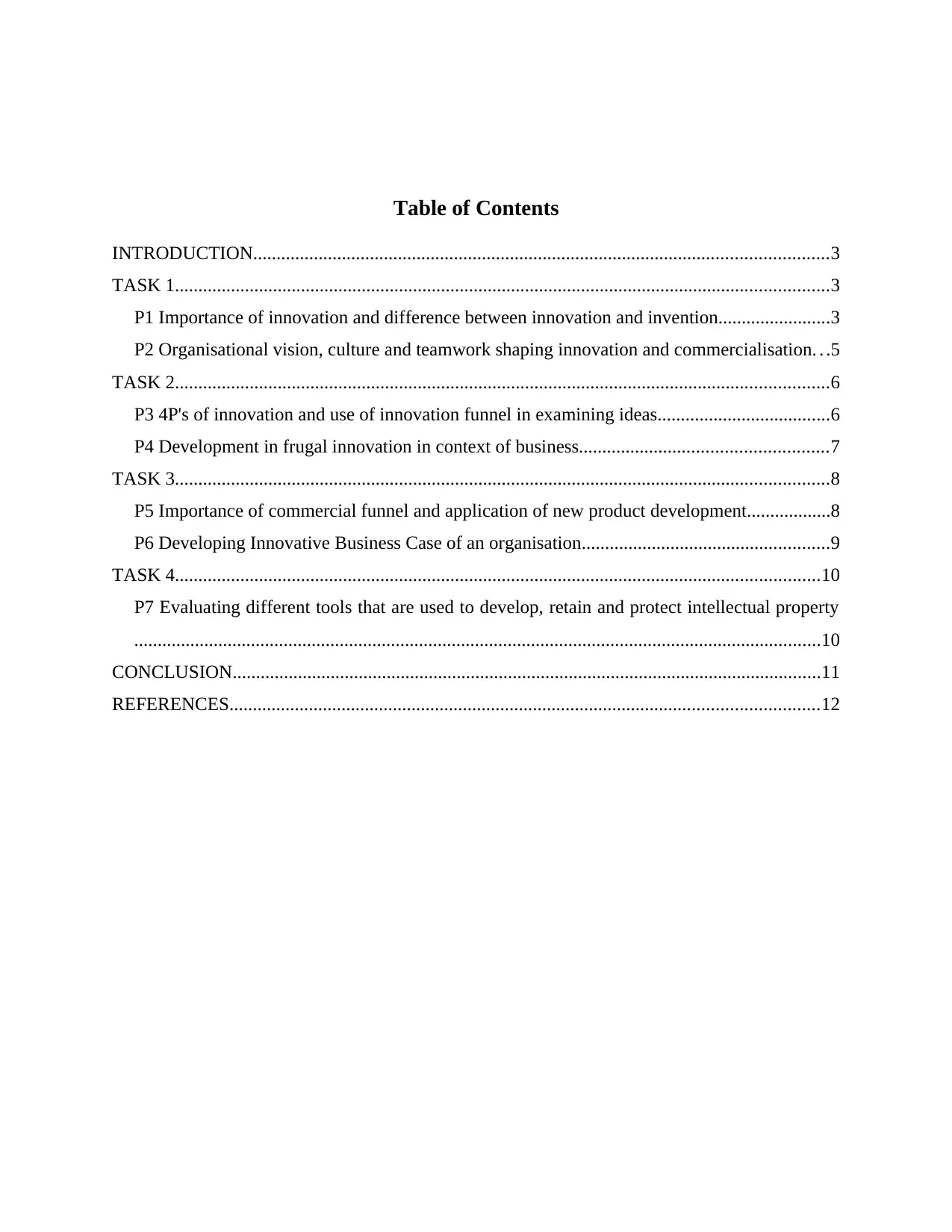
Table of Contents
INTRODUCTION...........................................................................................................................3
TASK 1............................................................................................................................................3
P1 Importance of innovation and difference between innovation and invention........................3
P2 Organisational vision, culture and teamwork shaping innovation and commercialisation. . .5
TASK 2............................................................................................................................................6
P3 4P's of innovation and use of innovation funnel in examining ideas.....................................6
P4 Development in frugal innovation in context of business.....................................................7
TASK 3............................................................................................................................................8
P5 Importance of commercial funnel and application of new product development..................8
P6 Developing Innovative Business Case of an organisation.....................................................9
TASK 4..........................................................................................................................................10
P7 Evaluating different tools that are used to develop, retain and protect intellectual property
...................................................................................................................................................10
CONCLUSION..............................................................................................................................11
REFERENCES..............................................................................................................................12
INTRODUCTION...........................................................................................................................3
TASK 1............................................................................................................................................3
P1 Importance of innovation and difference between innovation and invention........................3
P2 Organisational vision, culture and teamwork shaping innovation and commercialisation. . .5
TASK 2............................................................................................................................................6
P3 4P's of innovation and use of innovation funnel in examining ideas.....................................6
P4 Development in frugal innovation in context of business.....................................................7
TASK 3............................................................................................................................................8
P5 Importance of commercial funnel and application of new product development..................8
P6 Developing Innovative Business Case of an organisation.....................................................9
TASK 4..........................................................................................................................................10
P7 Evaluating different tools that are used to develop, retain and protect intellectual property
...................................................................................................................................................10
CONCLUSION..............................................................................................................................11
REFERENCES..............................................................................................................................12
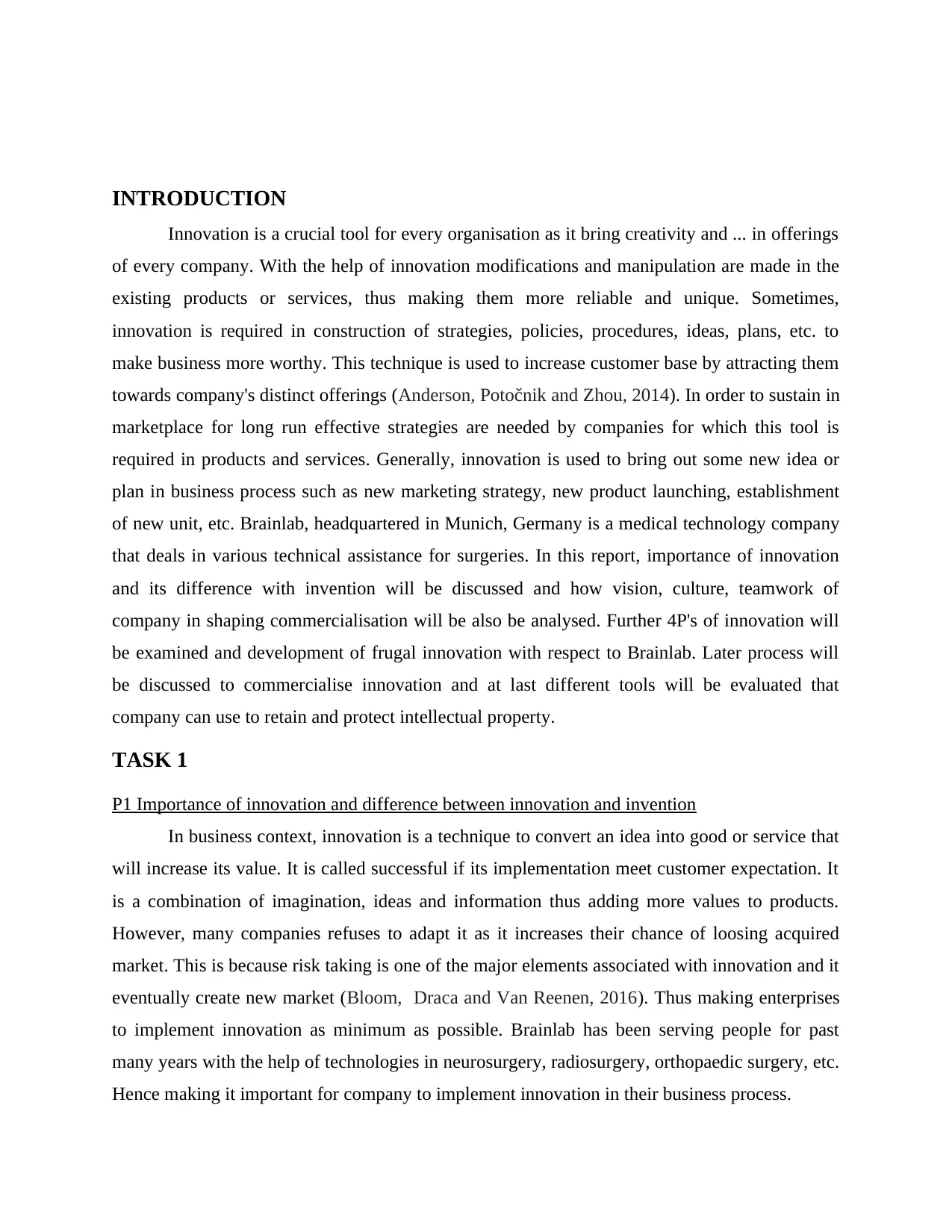
INTRODUCTION
Innovation is a crucial tool for every organisation as it bring creativity and ... in offerings
of every company. With the help of innovation modifications and manipulation are made in the
existing products or services, thus making them more reliable and unique. Sometimes,
innovation is required in construction of strategies, policies, procedures, ideas, plans, etc. to
make business more worthy. This technique is used to increase customer base by attracting them
towards company's distinct offerings (Anderson, Potočnik and Zhou, 2014). In order to sustain in
marketplace for long run effective strategies are needed by companies for which this tool is
required in products and services. Generally, innovation is used to bring out some new idea or
plan in business process such as new marketing strategy, new product launching, establishment
of new unit, etc. Brainlab, headquartered in Munich, Germany is a medical technology company
that deals in various technical assistance for surgeries. In this report, importance of innovation
and its difference with invention will be discussed and how vision, culture, teamwork of
company in shaping commercialisation will be also be analysed. Further 4P's of innovation will
be examined and development of frugal innovation with respect to Brainlab. Later process will
be discussed to commercialise innovation and at last different tools will be evaluated that
company can use to retain and protect intellectual property.
TASK 1
P1 Importance of innovation and difference between innovation and invention
In business context, innovation is a technique to convert an idea into good or service that
will increase its value. It is called successful if its implementation meet customer expectation. It
is a combination of imagination, ideas and information thus adding more values to products.
However, many companies refuses to adapt it as it increases their chance of loosing acquired
market. This is because risk taking is one of the major elements associated with innovation and it
eventually create new market (Bloom, Draca and Van Reenen, 2016). Thus making enterprises
to implement innovation as minimum as possible. Brainlab has been serving people for past
many years with the help of technologies in neurosurgery, radiosurgery, orthopaedic surgery, etc.
Hence making it important for company to implement innovation in their business process.
Innovation is a crucial tool for every organisation as it bring creativity and ... in offerings
of every company. With the help of innovation modifications and manipulation are made in the
existing products or services, thus making them more reliable and unique. Sometimes,
innovation is required in construction of strategies, policies, procedures, ideas, plans, etc. to
make business more worthy. This technique is used to increase customer base by attracting them
towards company's distinct offerings (Anderson, Potočnik and Zhou, 2014). In order to sustain in
marketplace for long run effective strategies are needed by companies for which this tool is
required in products and services. Generally, innovation is used to bring out some new idea or
plan in business process such as new marketing strategy, new product launching, establishment
of new unit, etc. Brainlab, headquartered in Munich, Germany is a medical technology company
that deals in various technical assistance for surgeries. In this report, importance of innovation
and its difference with invention will be discussed and how vision, culture, teamwork of
company in shaping commercialisation will be also be analysed. Further 4P's of innovation will
be examined and development of frugal innovation with respect to Brainlab. Later process will
be discussed to commercialise innovation and at last different tools will be evaluated that
company can use to retain and protect intellectual property.
TASK 1
P1 Importance of innovation and difference between innovation and invention
In business context, innovation is a technique to convert an idea into good or service that
will increase its value. It is called successful if its implementation meet customer expectation. It
is a combination of imagination, ideas and information thus adding more values to products.
However, many companies refuses to adapt it as it increases their chance of loosing acquired
market. This is because risk taking is one of the major elements associated with innovation and it
eventually create new market (Bloom, Draca and Van Reenen, 2016). Thus making enterprises
to implement innovation as minimum as possible. Brainlab has been serving people for past
many years with the help of technologies in neurosurgery, radiosurgery, orthopaedic surgery, etc.
Hence making it important for company to implement innovation in their business process.
⊘ This is a preview!⊘
Do you want full access?
Subscribe today to unlock all pages.

Trusted by 1+ million students worldwide
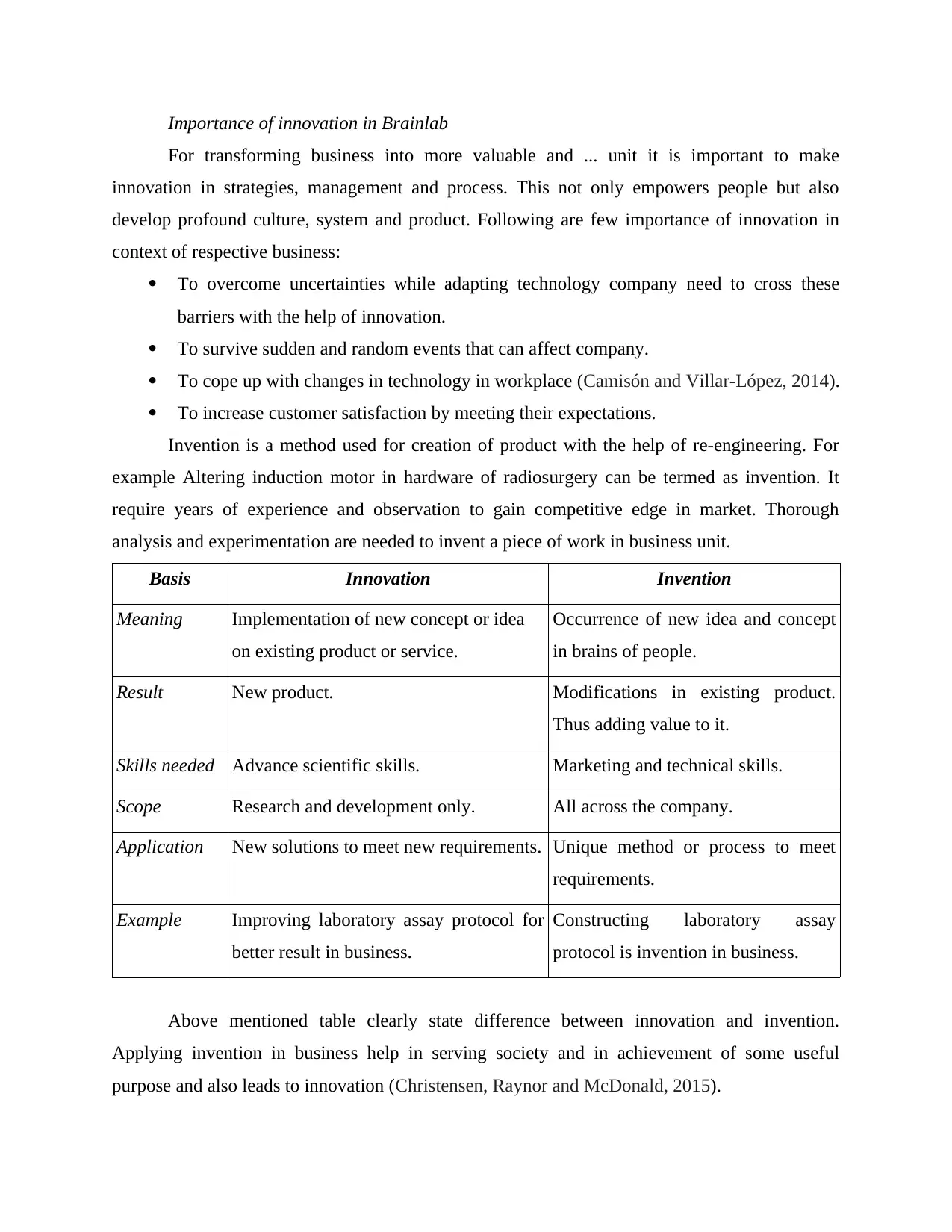
Importance of innovation in Brainlab
For transforming business into more valuable and ... unit it is important to make
innovation in strategies, management and process. This not only empowers people but also
develop profound culture, system and product. Following are few importance of innovation in
context of respective business:
To overcome uncertainties while adapting technology company need to cross these
barriers with the help of innovation.
To survive sudden and random events that can affect company.
To cope up with changes in technology in workplace (Camisón and Villar-López, 2014).
To increase customer satisfaction by meeting their expectations.
Invention is a method used for creation of product with the help of re-engineering. For
example Altering induction motor in hardware of radiosurgery can be termed as invention. It
require years of experience and observation to gain competitive edge in market. Thorough
analysis and experimentation are needed to invent a piece of work in business unit.
Basis Innovation Invention
Meaning Implementation of new concept or idea
on existing product or service.
Occurrence of new idea and concept
in brains of people.
Result New product. Modifications in existing product.
Thus adding value to it.
Skills needed Advance scientific skills. Marketing and technical skills.
Scope Research and development only. All across the company.
Application New solutions to meet new requirements. Unique method or process to meet
requirements.
Example Improving laboratory assay protocol for
better result in business.
Constructing laboratory assay
protocol is invention in business.
Above mentioned table clearly state difference between innovation and invention.
Applying invention in business help in serving society and in achievement of some useful
purpose and also leads to innovation (Christensen, Raynor and McDonald, 2015).
For transforming business into more valuable and ... unit it is important to make
innovation in strategies, management and process. This not only empowers people but also
develop profound culture, system and product. Following are few importance of innovation in
context of respective business:
To overcome uncertainties while adapting technology company need to cross these
barriers with the help of innovation.
To survive sudden and random events that can affect company.
To cope up with changes in technology in workplace (Camisón and Villar-López, 2014).
To increase customer satisfaction by meeting their expectations.
Invention is a method used for creation of product with the help of re-engineering. For
example Altering induction motor in hardware of radiosurgery can be termed as invention. It
require years of experience and observation to gain competitive edge in market. Thorough
analysis and experimentation are needed to invent a piece of work in business unit.
Basis Innovation Invention
Meaning Implementation of new concept or idea
on existing product or service.
Occurrence of new idea and concept
in brains of people.
Result New product. Modifications in existing product.
Thus adding value to it.
Skills needed Advance scientific skills. Marketing and technical skills.
Scope Research and development only. All across the company.
Application New solutions to meet new requirements. Unique method or process to meet
requirements.
Example Improving laboratory assay protocol for
better result in business.
Constructing laboratory assay
protocol is invention in business.
Above mentioned table clearly state difference between innovation and invention.
Applying invention in business help in serving society and in achievement of some useful
purpose and also leads to innovation (Christensen, Raynor and McDonald, 2015).
Paraphrase This Document
Need a fresh take? Get an instant paraphrase of this document with our AI Paraphraser
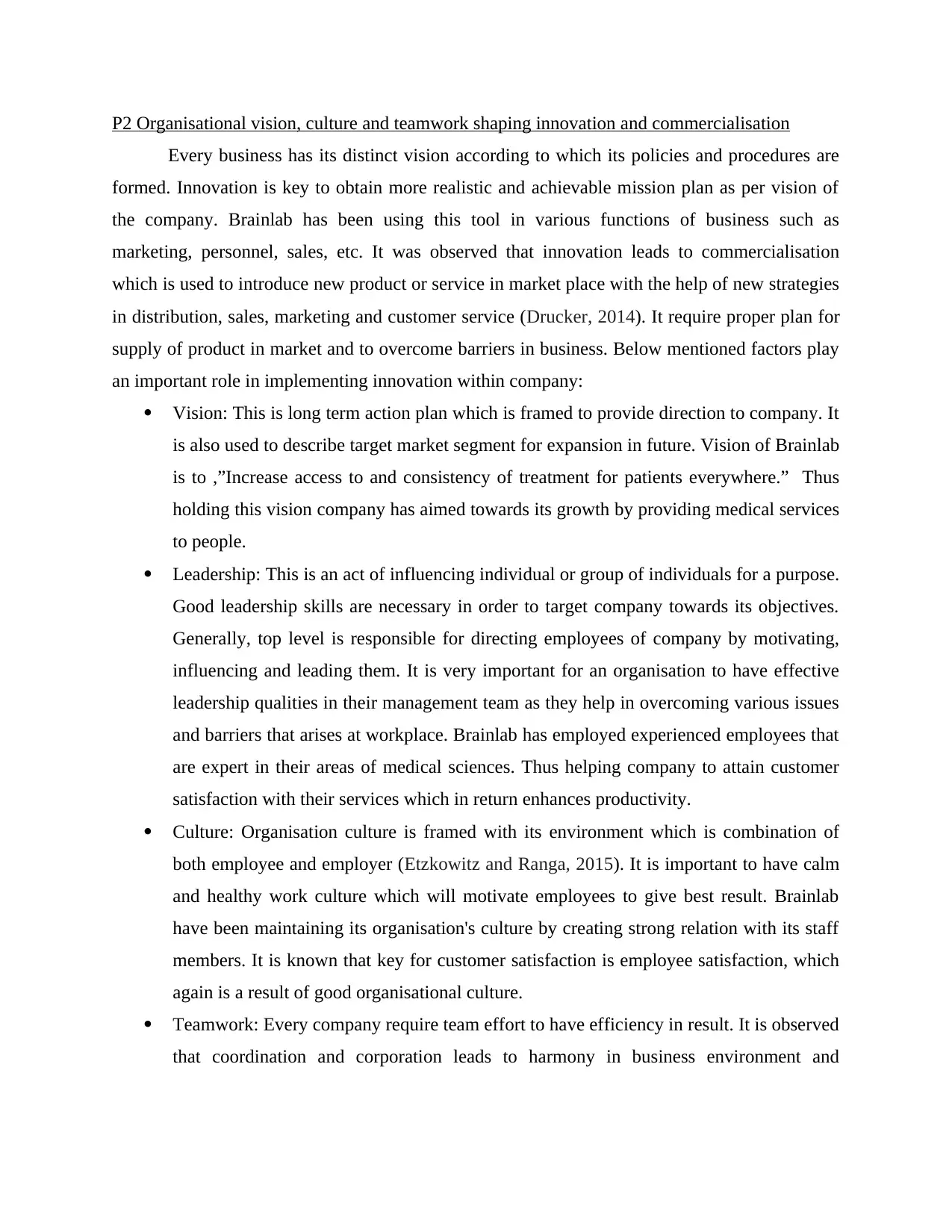
P2 Organisational vision, culture and teamwork shaping innovation and commercialisation
Every business has its distinct vision according to which its policies and procedures are
formed. Innovation is key to obtain more realistic and achievable mission plan as per vision of
the company. Brainlab has been using this tool in various functions of business such as
marketing, personnel, sales, etc. It was observed that innovation leads to commercialisation
which is used to introduce new product or service in market place with the help of new strategies
in distribution, sales, marketing and customer service (Drucker, 2014). It require proper plan for
supply of product in market and to overcome barriers in business. Below mentioned factors play
an important role in implementing innovation within company:
Vision: This is long term action plan which is framed to provide direction to company. It
is also used to describe target market segment for expansion in future. Vision of Brainlab
is to ,”Increase access to and consistency of treatment for patients everywhere.” Thus
holding this vision company has aimed towards its growth by providing medical services
to people.
Leadership: This is an act of influencing individual or group of individuals for a purpose.
Good leadership skills are necessary in order to target company towards its objectives.
Generally, top level is responsible for directing employees of company by motivating,
influencing and leading them. It is very important for an organisation to have effective
leadership qualities in their management team as they help in overcoming various issues
and barriers that arises at workplace. Brainlab has employed experienced employees that
are expert in their areas of medical sciences. Thus helping company to attain customer
satisfaction with their services which in return enhances productivity.
Culture: Organisation culture is framed with its environment which is combination of
both employee and employer (Etzkowitz and Ranga, 2015). It is important to have calm
and healthy work culture which will motivate employees to give best result. Brainlab
have been maintaining its organisation's culture by creating strong relation with its staff
members. It is known that key for customer satisfaction is employee satisfaction, which
again is a result of good organisational culture.
Teamwork: Every company require team effort to have efficiency in result. It is observed
that coordination and corporation leads to harmony in business environment and
Every business has its distinct vision according to which its policies and procedures are
formed. Innovation is key to obtain more realistic and achievable mission plan as per vision of
the company. Brainlab has been using this tool in various functions of business such as
marketing, personnel, sales, etc. It was observed that innovation leads to commercialisation
which is used to introduce new product or service in market place with the help of new strategies
in distribution, sales, marketing and customer service (Drucker, 2014). It require proper plan for
supply of product in market and to overcome barriers in business. Below mentioned factors play
an important role in implementing innovation within company:
Vision: This is long term action plan which is framed to provide direction to company. It
is also used to describe target market segment for expansion in future. Vision of Brainlab
is to ,”Increase access to and consistency of treatment for patients everywhere.” Thus
holding this vision company has aimed towards its growth by providing medical services
to people.
Leadership: This is an act of influencing individual or group of individuals for a purpose.
Good leadership skills are necessary in order to target company towards its objectives.
Generally, top level is responsible for directing employees of company by motivating,
influencing and leading them. It is very important for an organisation to have effective
leadership qualities in their management team as they help in overcoming various issues
and barriers that arises at workplace. Brainlab has employed experienced employees that
are expert in their areas of medical sciences. Thus helping company to attain customer
satisfaction with their services which in return enhances productivity.
Culture: Organisation culture is framed with its environment which is combination of
both employee and employer (Etzkowitz and Ranga, 2015). It is important to have calm
and healthy work culture which will motivate employees to give best result. Brainlab
have been maintaining its organisation's culture by creating strong relation with its staff
members. It is known that key for customer satisfaction is employee satisfaction, which
again is a result of good organisational culture.
Teamwork: Every company require team effort to have efficiency in result. It is observed
that coordination and corporation leads to harmony in business environment and
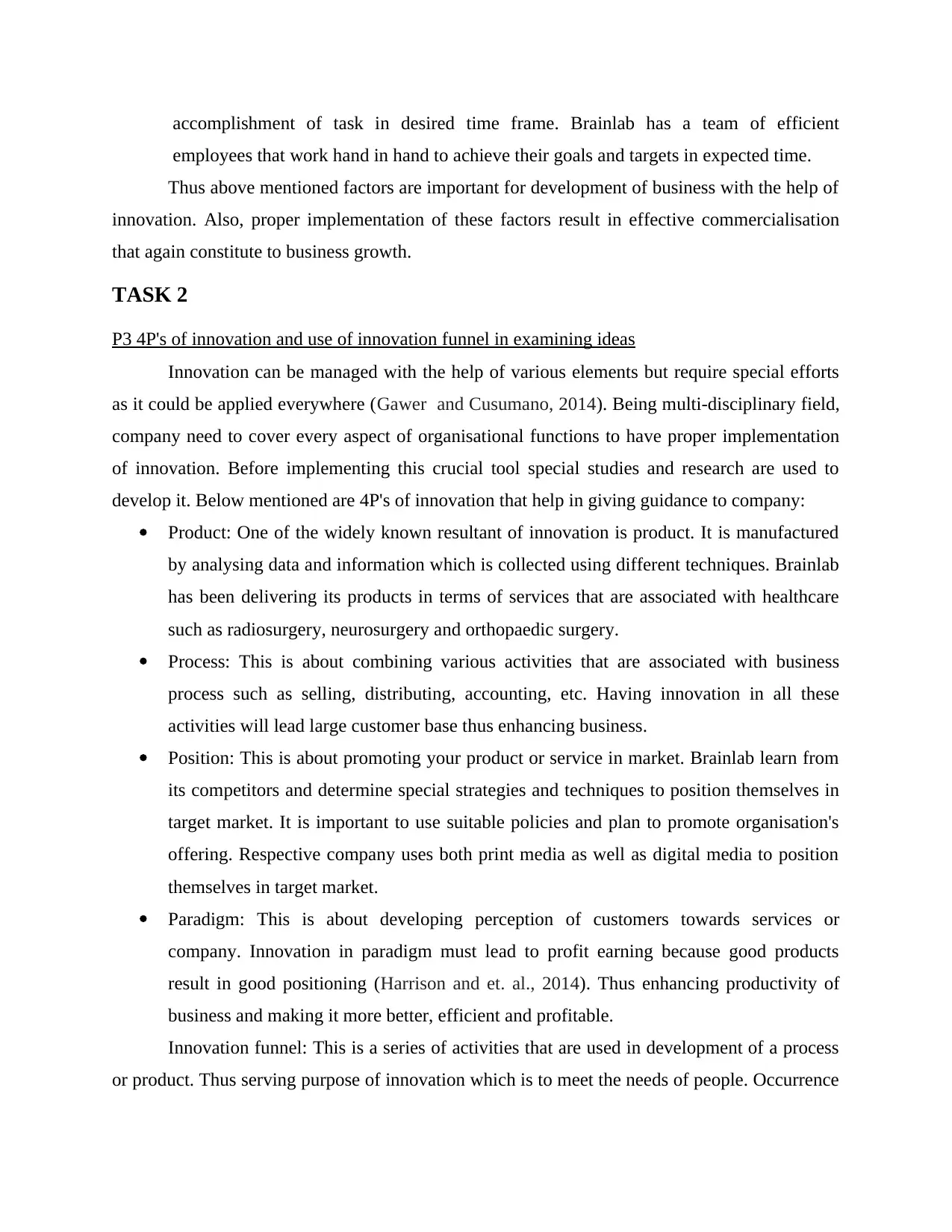
accomplishment of task in desired time frame. Brainlab has a team of efficient
employees that work hand in hand to achieve their goals and targets in expected time.
Thus above mentioned factors are important for development of business with the help of
innovation. Also, proper implementation of these factors result in effective commercialisation
that again constitute to business growth.
TASK 2
P3 4P's of innovation and use of innovation funnel in examining ideas
Innovation can be managed with the help of various elements but require special efforts
as it could be applied everywhere (Gawer and Cusumano, 2014). Being multi-disciplinary field,
company need to cover every aspect of organisational functions to have proper implementation
of innovation. Before implementing this crucial tool special studies and research are used to
develop it. Below mentioned are 4P's of innovation that help in giving guidance to company:
Product: One of the widely known resultant of innovation is product. It is manufactured
by analysing data and information which is collected using different techniques. Brainlab
has been delivering its products in terms of services that are associated with healthcare
such as radiosurgery, neurosurgery and orthopaedic surgery.
Process: This is about combining various activities that are associated with business
process such as selling, distributing, accounting, etc. Having innovation in all these
activities will lead large customer base thus enhancing business.
Position: This is about promoting your product or service in market. Brainlab learn from
its competitors and determine special strategies and techniques to position themselves in
target market. It is important to use suitable policies and plan to promote organisation's
offering. Respective company uses both print media as well as digital media to position
themselves in target market.
Paradigm: This is about developing perception of customers towards services or
company. Innovation in paradigm must lead to profit earning because good products
result in good positioning (Harrison and et. al., 2014). Thus enhancing productivity of
business and making it more better, efficient and profitable.
Innovation funnel: This is a series of activities that are used in development of a process
or product. Thus serving purpose of innovation which is to meet the needs of people. Occurrence
employees that work hand in hand to achieve their goals and targets in expected time.
Thus above mentioned factors are important for development of business with the help of
innovation. Also, proper implementation of these factors result in effective commercialisation
that again constitute to business growth.
TASK 2
P3 4P's of innovation and use of innovation funnel in examining ideas
Innovation can be managed with the help of various elements but require special efforts
as it could be applied everywhere (Gawer and Cusumano, 2014). Being multi-disciplinary field,
company need to cover every aspect of organisational functions to have proper implementation
of innovation. Before implementing this crucial tool special studies and research are used to
develop it. Below mentioned are 4P's of innovation that help in giving guidance to company:
Product: One of the widely known resultant of innovation is product. It is manufactured
by analysing data and information which is collected using different techniques. Brainlab
has been delivering its products in terms of services that are associated with healthcare
such as radiosurgery, neurosurgery and orthopaedic surgery.
Process: This is about combining various activities that are associated with business
process such as selling, distributing, accounting, etc. Having innovation in all these
activities will lead large customer base thus enhancing business.
Position: This is about promoting your product or service in market. Brainlab learn from
its competitors and determine special strategies and techniques to position themselves in
target market. It is important to use suitable policies and plan to promote organisation's
offering. Respective company uses both print media as well as digital media to position
themselves in target market.
Paradigm: This is about developing perception of customers towards services or
company. Innovation in paradigm must lead to profit earning because good products
result in good positioning (Harrison and et. al., 2014). Thus enhancing productivity of
business and making it more better, efficient and profitable.
Innovation funnel: This is a series of activities that are used in development of a process
or product. Thus serving purpose of innovation which is to meet the needs of people. Occurrence
⊘ This is a preview!⊘
Do you want full access?
Subscribe today to unlock all pages.

Trusted by 1+ million students worldwide
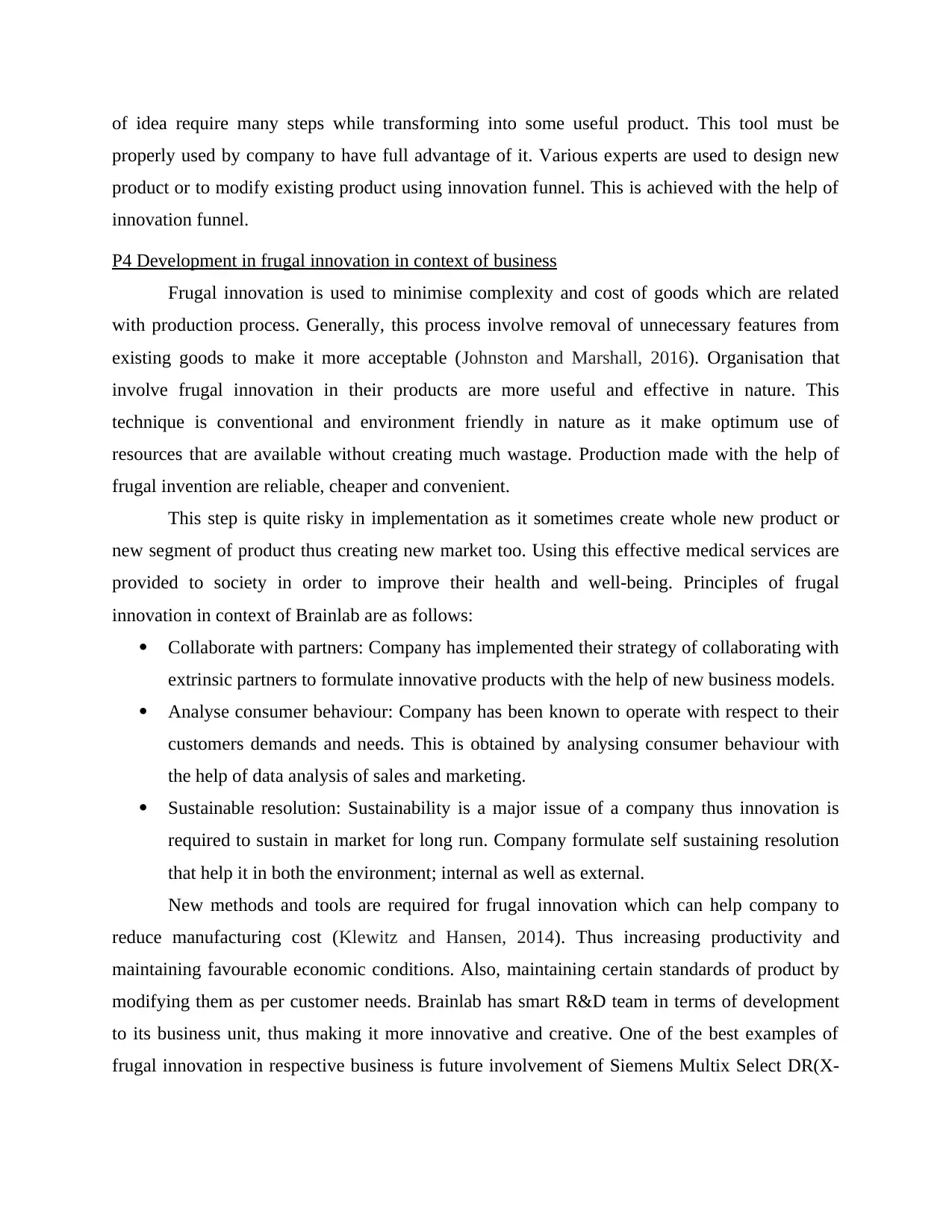
of idea require many steps while transforming into some useful product. This tool must be
properly used by company to have full advantage of it. Various experts are used to design new
product or to modify existing product using innovation funnel. This is achieved with the help of
innovation funnel.
P4 Development in frugal innovation in context of business
Frugal innovation is used to minimise complexity and cost of goods which are related
with production process. Generally, this process involve removal of unnecessary features from
existing goods to make it more acceptable (Johnston and Marshall, 2016). Organisation that
involve frugal innovation in their products are more useful and effective in nature. This
technique is conventional and environment friendly in nature as it make optimum use of
resources that are available without creating much wastage. Production made with the help of
frugal invention are reliable, cheaper and convenient.
This step is quite risky in implementation as it sometimes create whole new product or
new segment of product thus creating new market too. Using this effective medical services are
provided to society in order to improve their health and well-being. Principles of frugal
innovation in context of Brainlab are as follows:
Collaborate with partners: Company has implemented their strategy of collaborating with
extrinsic partners to formulate innovative products with the help of new business models.
Analyse consumer behaviour: Company has been known to operate with respect to their
customers demands and needs. This is obtained by analysing consumer behaviour with
the help of data analysis of sales and marketing.
Sustainable resolution: Sustainability is a major issue of a company thus innovation is
required to sustain in market for long run. Company formulate self sustaining resolution
that help it in both the environment; internal as well as external.
New methods and tools are required for frugal innovation which can help company to
reduce manufacturing cost (Klewitz and Hansen, 2014). Thus increasing productivity and
maintaining favourable economic conditions. Also, maintaining certain standards of product by
modifying them as per customer needs. Brainlab has smart R&D team in terms of development
to its business unit, thus making it more innovative and creative. One of the best examples of
frugal innovation in respective business is future involvement of Siemens Multix Select DR(X-
properly used by company to have full advantage of it. Various experts are used to design new
product or to modify existing product using innovation funnel. This is achieved with the help of
innovation funnel.
P4 Development in frugal innovation in context of business
Frugal innovation is used to minimise complexity and cost of goods which are related
with production process. Generally, this process involve removal of unnecessary features from
existing goods to make it more acceptable (Johnston and Marshall, 2016). Organisation that
involve frugal innovation in their products are more useful and effective in nature. This
technique is conventional and environment friendly in nature as it make optimum use of
resources that are available without creating much wastage. Production made with the help of
frugal invention are reliable, cheaper and convenient.
This step is quite risky in implementation as it sometimes create whole new product or
new segment of product thus creating new market too. Using this effective medical services are
provided to society in order to improve their health and well-being. Principles of frugal
innovation in context of Brainlab are as follows:
Collaborate with partners: Company has implemented their strategy of collaborating with
extrinsic partners to formulate innovative products with the help of new business models.
Analyse consumer behaviour: Company has been known to operate with respect to their
customers demands and needs. This is obtained by analysing consumer behaviour with
the help of data analysis of sales and marketing.
Sustainable resolution: Sustainability is a major issue of a company thus innovation is
required to sustain in market for long run. Company formulate self sustaining resolution
that help it in both the environment; internal as well as external.
New methods and tools are required for frugal innovation which can help company to
reduce manufacturing cost (Klewitz and Hansen, 2014). Thus increasing productivity and
maintaining favourable economic conditions. Also, maintaining certain standards of product by
modifying them as per customer needs. Brainlab has smart R&D team in terms of development
to its business unit, thus making it more innovative and creative. One of the best examples of
frugal innovation in respective business is future involvement of Siemens Multix Select DR(X-
Paraphrase This Document
Need a fresh take? Get an instant paraphrase of this document with our AI Paraphraser
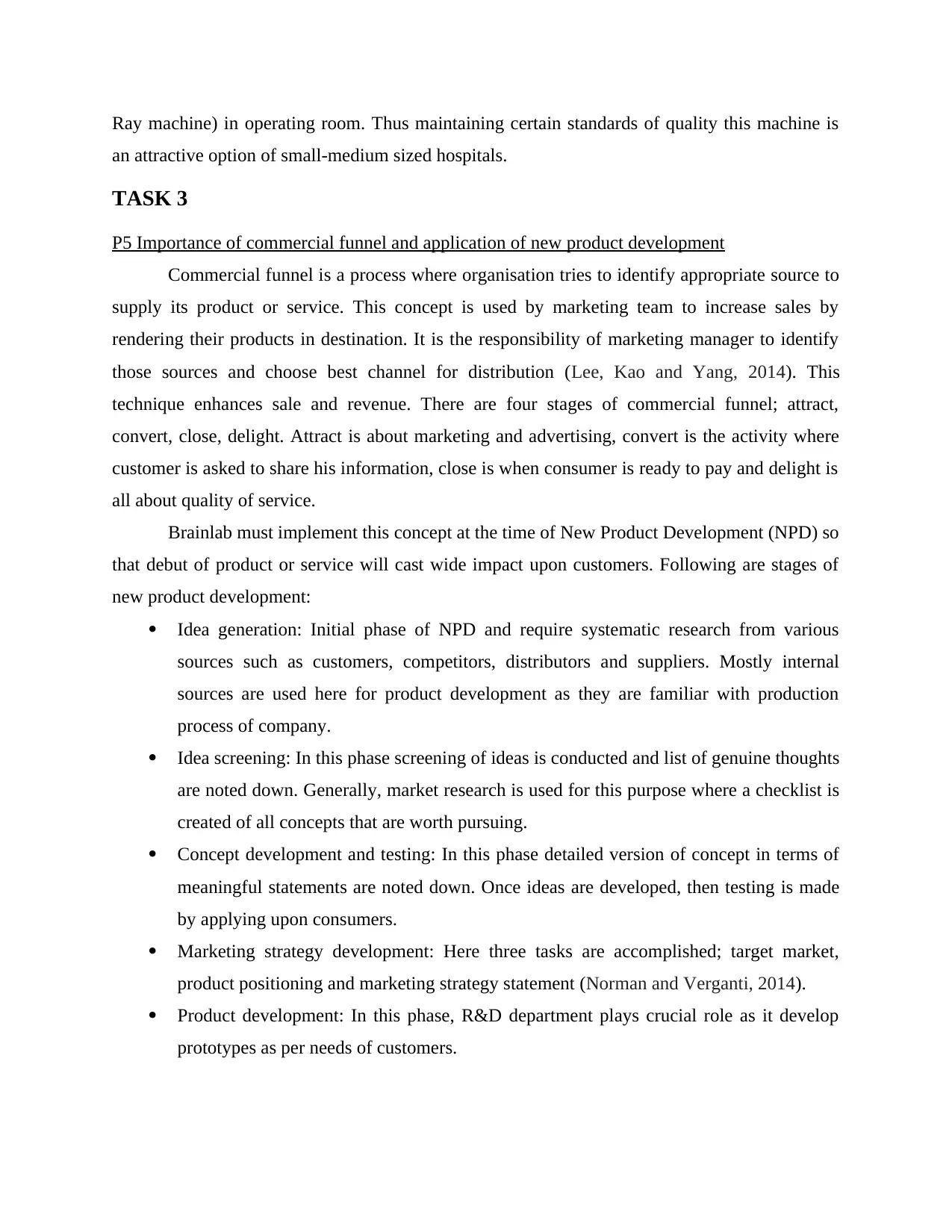
Ray machine) in operating room. Thus maintaining certain standards of quality this machine is
an attractive option of small-medium sized hospitals.
TASK 3
P5 Importance of commercial funnel and application of new product development
Commercial funnel is a process where organisation tries to identify appropriate source to
supply its product or service. This concept is used by marketing team to increase sales by
rendering their products in destination. It is the responsibility of marketing manager to identify
those sources and choose best channel for distribution (Lee, Kao and Yang, 2014). This
technique enhances sale and revenue. There are four stages of commercial funnel; attract,
convert, close, delight. Attract is about marketing and advertising, convert is the activity where
customer is asked to share his information, close is when consumer is ready to pay and delight is
all about quality of service.
Brainlab must implement this concept at the time of New Product Development (NPD) so
that debut of product or service will cast wide impact upon customers. Following are stages of
new product development:
Idea generation: Initial phase of NPD and require systematic research from various
sources such as customers, competitors, distributors and suppliers. Mostly internal
sources are used here for product development as they are familiar with production
process of company.
Idea screening: In this phase screening of ideas is conducted and list of genuine thoughts
are noted down. Generally, market research is used for this purpose where a checklist is
created of all concepts that are worth pursuing.
Concept development and testing: In this phase detailed version of concept in terms of
meaningful statements are noted down. Once ideas are developed, then testing is made
by applying upon consumers.
Marketing strategy development: Here three tasks are accomplished; target market,
product positioning and marketing strategy statement (Norman and Verganti, 2014).
Product development: In this phase, R&D department plays crucial role as it develop
prototypes as per needs of customers.
an attractive option of small-medium sized hospitals.
TASK 3
P5 Importance of commercial funnel and application of new product development
Commercial funnel is a process where organisation tries to identify appropriate source to
supply its product or service. This concept is used by marketing team to increase sales by
rendering their products in destination. It is the responsibility of marketing manager to identify
those sources and choose best channel for distribution (Lee, Kao and Yang, 2014). This
technique enhances sale and revenue. There are four stages of commercial funnel; attract,
convert, close, delight. Attract is about marketing and advertising, convert is the activity where
customer is asked to share his information, close is when consumer is ready to pay and delight is
all about quality of service.
Brainlab must implement this concept at the time of New Product Development (NPD) so
that debut of product or service will cast wide impact upon customers. Following are stages of
new product development:
Idea generation: Initial phase of NPD and require systematic research from various
sources such as customers, competitors, distributors and suppliers. Mostly internal
sources are used here for product development as they are familiar with production
process of company.
Idea screening: In this phase screening of ideas is conducted and list of genuine thoughts
are noted down. Generally, market research is used for this purpose where a checklist is
created of all concepts that are worth pursuing.
Concept development and testing: In this phase detailed version of concept in terms of
meaningful statements are noted down. Once ideas are developed, then testing is made
by applying upon consumers.
Marketing strategy development: Here three tasks are accomplished; target market,
product positioning and marketing strategy statement (Norman and Verganti, 2014).
Product development: In this phase, R&D department plays crucial role as it develop
prototypes as per needs of customers.
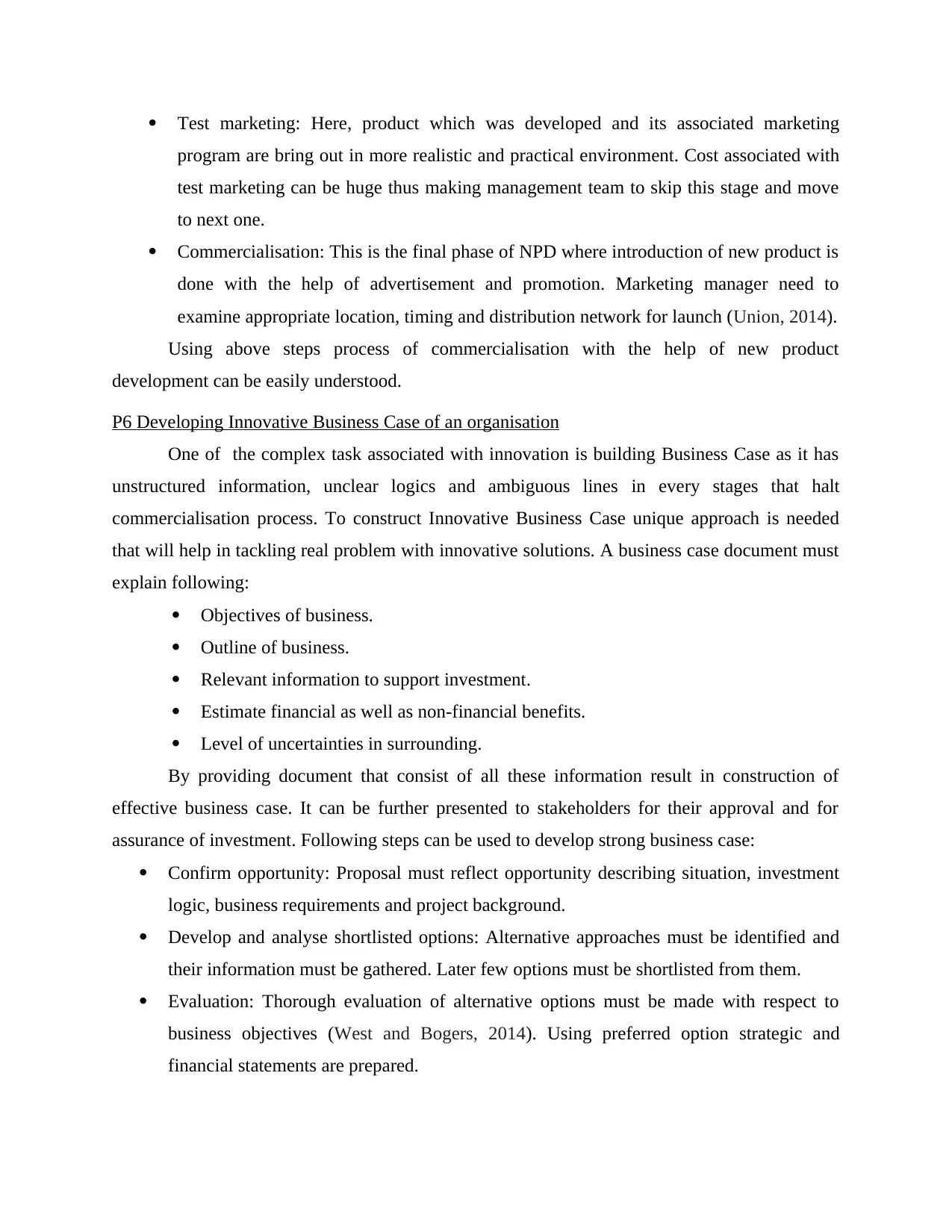
Test marketing: Here, product which was developed and its associated marketing
program are bring out in more realistic and practical environment. Cost associated with
test marketing can be huge thus making management team to skip this stage and move
to next one.
Commercialisation: This is the final phase of NPD where introduction of new product is
done with the help of advertisement and promotion. Marketing manager need to
examine appropriate location, timing and distribution network for launch (Union, 2014).
Using above steps process of commercialisation with the help of new product
development can be easily understood.
P6 Developing Innovative Business Case of an organisation
One of the complex task associated with innovation is building Business Case as it has
unstructured information, unclear logics and ambiguous lines in every stages that halt
commercialisation process. To construct Innovative Business Case unique approach is needed
that will help in tackling real problem with innovative solutions. A business case document must
explain following:
Objectives of business.
Outline of business.
Relevant information to support investment.
Estimate financial as well as non-financial benefits.
Level of uncertainties in surrounding.
By providing document that consist of all these information result in construction of
effective business case. It can be further presented to stakeholders for their approval and for
assurance of investment. Following steps can be used to develop strong business case:
Confirm opportunity: Proposal must reflect opportunity describing situation, investment
logic, business requirements and project background.
Develop and analyse shortlisted options: Alternative approaches must be identified and
their information must be gathered. Later few options must be shortlisted from them.
Evaluation: Thorough evaluation of alternative options must be made with respect to
business objectives (West and Bogers, 2014). Using preferred option strategic and
financial statements are prepared.
program are bring out in more realistic and practical environment. Cost associated with
test marketing can be huge thus making management team to skip this stage and move
to next one.
Commercialisation: This is the final phase of NPD where introduction of new product is
done with the help of advertisement and promotion. Marketing manager need to
examine appropriate location, timing and distribution network for launch (Union, 2014).
Using above steps process of commercialisation with the help of new product
development can be easily understood.
P6 Developing Innovative Business Case of an organisation
One of the complex task associated with innovation is building Business Case as it has
unstructured information, unclear logics and ambiguous lines in every stages that halt
commercialisation process. To construct Innovative Business Case unique approach is needed
that will help in tackling real problem with innovative solutions. A business case document must
explain following:
Objectives of business.
Outline of business.
Relevant information to support investment.
Estimate financial as well as non-financial benefits.
Level of uncertainties in surrounding.
By providing document that consist of all these information result in construction of
effective business case. It can be further presented to stakeholders for their approval and for
assurance of investment. Following steps can be used to develop strong business case:
Confirm opportunity: Proposal must reflect opportunity describing situation, investment
logic, business requirements and project background.
Develop and analyse shortlisted options: Alternative approaches must be identified and
their information must be gathered. Later few options must be shortlisted from them.
Evaluation: Thorough evaluation of alternative options must be made with respect to
business objectives (West and Bogers, 2014). Using preferred option strategic and
financial statements are prepared.
⊘ This is a preview!⊘
Do you want full access?
Subscribe today to unlock all pages.

Trusted by 1+ million students worldwide
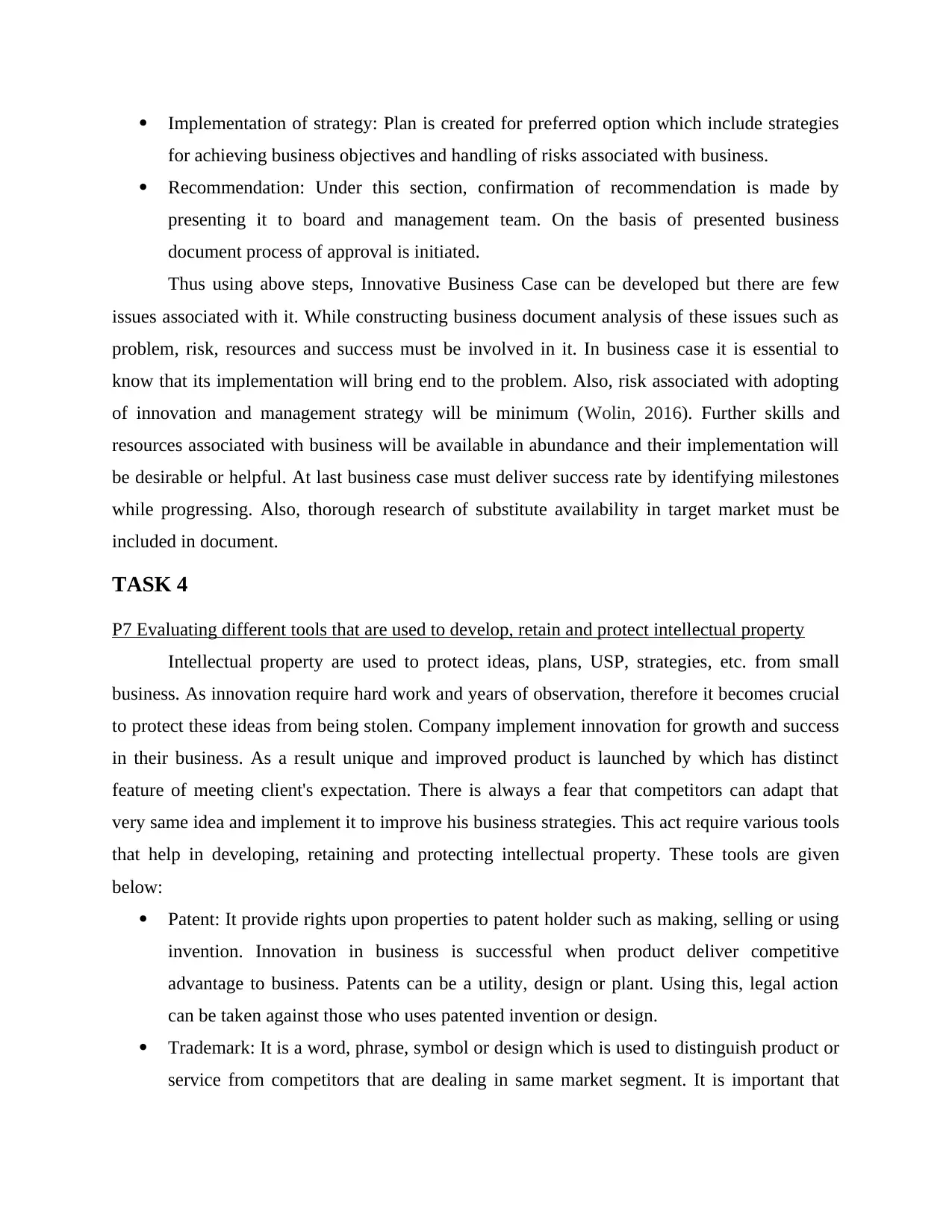
Implementation of strategy: Plan is created for preferred option which include strategies
for achieving business objectives and handling of risks associated with business.
Recommendation: Under this section, confirmation of recommendation is made by
presenting it to board and management team. On the basis of presented business
document process of approval is initiated.
Thus using above steps, Innovative Business Case can be developed but there are few
issues associated with it. While constructing business document analysis of these issues such as
problem, risk, resources and success must be involved in it. In business case it is essential to
know that its implementation will bring end to the problem. Also, risk associated with adopting
of innovation and management strategy will be minimum (Wolin, 2016). Further skills and
resources associated with business will be available in abundance and their implementation will
be desirable or helpful. At last business case must deliver success rate by identifying milestones
while progressing. Also, thorough research of substitute availability in target market must be
included in document.
TASK 4
P7 Evaluating different tools that are used to develop, retain and protect intellectual property
Intellectual property are used to protect ideas, plans, USP, strategies, etc. from small
business. As innovation require hard work and years of observation, therefore it becomes crucial
to protect these ideas from being stolen. Company implement innovation for growth and success
in their business. As a result unique and improved product is launched by which has distinct
feature of meeting client's expectation. There is always a fear that competitors can adapt that
very same idea and implement it to improve his business strategies. This act require various tools
that help in developing, retaining and protecting intellectual property. These tools are given
below:
Patent: It provide rights upon properties to patent holder such as making, selling or using
invention. Innovation in business is successful when product deliver competitive
advantage to business. Patents can be a utility, design or plant. Using this, legal action
can be taken against those who uses patented invention or design.
Trademark: It is a word, phrase, symbol or design which is used to distinguish product or
service from competitors that are dealing in same market segment. It is important that
for achieving business objectives and handling of risks associated with business.
Recommendation: Under this section, confirmation of recommendation is made by
presenting it to board and management team. On the basis of presented business
document process of approval is initiated.
Thus using above steps, Innovative Business Case can be developed but there are few
issues associated with it. While constructing business document analysis of these issues such as
problem, risk, resources and success must be involved in it. In business case it is essential to
know that its implementation will bring end to the problem. Also, risk associated with adopting
of innovation and management strategy will be minimum (Wolin, 2016). Further skills and
resources associated with business will be available in abundance and their implementation will
be desirable or helpful. At last business case must deliver success rate by identifying milestones
while progressing. Also, thorough research of substitute availability in target market must be
included in document.
TASK 4
P7 Evaluating different tools that are used to develop, retain and protect intellectual property
Intellectual property are used to protect ideas, plans, USP, strategies, etc. from small
business. As innovation require hard work and years of observation, therefore it becomes crucial
to protect these ideas from being stolen. Company implement innovation for growth and success
in their business. As a result unique and improved product is launched by which has distinct
feature of meeting client's expectation. There is always a fear that competitors can adapt that
very same idea and implement it to improve his business strategies. This act require various tools
that help in developing, retaining and protecting intellectual property. These tools are given
below:
Patent: It provide rights upon properties to patent holder such as making, selling or using
invention. Innovation in business is successful when product deliver competitive
advantage to business. Patents can be a utility, design or plant. Using this, legal action
can be taken against those who uses patented invention or design.
Trademark: It is a word, phrase, symbol or design which is used to distinguish product or
service from competitors that are dealing in same market segment. It is important that
Paraphrase This Document
Need a fresh take? Get an instant paraphrase of this document with our AI Paraphraser
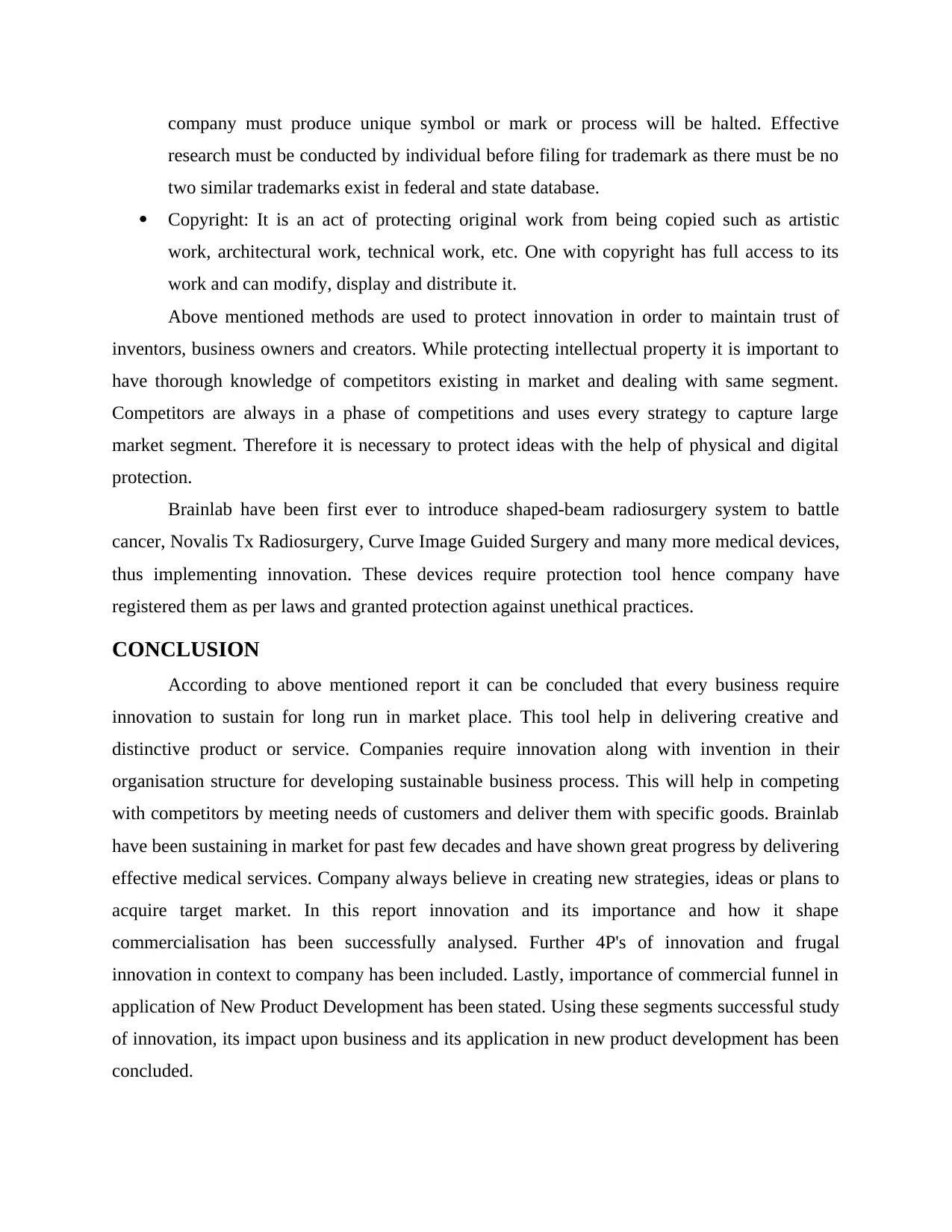
company must produce unique symbol or mark or process will be halted. Effective
research must be conducted by individual before filing for trademark as there must be no
two similar trademarks exist in federal and state database.
Copyright: It is an act of protecting original work from being copied such as artistic
work, architectural work, technical work, etc. One with copyright has full access to its
work and can modify, display and distribute it.
Above mentioned methods are used to protect innovation in order to maintain trust of
inventors, business owners and creators. While protecting intellectual property it is important to
have thorough knowledge of competitors existing in market and dealing with same segment.
Competitors are always in a phase of competitions and uses every strategy to capture large
market segment. Therefore it is necessary to protect ideas with the help of physical and digital
protection.
Brainlab have been first ever to introduce shaped-beam radiosurgery system to battle
cancer, Novalis Tx Radiosurgery, Curve Image Guided Surgery and many more medical devices,
thus implementing innovation. These devices require protection tool hence company have
registered them as per laws and granted protection against unethical practices.
CONCLUSION
According to above mentioned report it can be concluded that every business require
innovation to sustain for long run in market place. This tool help in delivering creative and
distinctive product or service. Companies require innovation along with invention in their
organisation structure for developing sustainable business process. This will help in competing
with competitors by meeting needs of customers and deliver them with specific goods. Brainlab
have been sustaining in market for past few decades and have shown great progress by delivering
effective medical services. Company always believe in creating new strategies, ideas or plans to
acquire target market. In this report innovation and its importance and how it shape
commercialisation has been successfully analysed. Further 4P's of innovation and frugal
innovation in context to company has been included. Lastly, importance of commercial funnel in
application of New Product Development has been stated. Using these segments successful study
of innovation, its impact upon business and its application in new product development has been
concluded.
research must be conducted by individual before filing for trademark as there must be no
two similar trademarks exist in federal and state database.
Copyright: It is an act of protecting original work from being copied such as artistic
work, architectural work, technical work, etc. One with copyright has full access to its
work and can modify, display and distribute it.
Above mentioned methods are used to protect innovation in order to maintain trust of
inventors, business owners and creators. While protecting intellectual property it is important to
have thorough knowledge of competitors existing in market and dealing with same segment.
Competitors are always in a phase of competitions and uses every strategy to capture large
market segment. Therefore it is necessary to protect ideas with the help of physical and digital
protection.
Brainlab have been first ever to introduce shaped-beam radiosurgery system to battle
cancer, Novalis Tx Radiosurgery, Curve Image Guided Surgery and many more medical devices,
thus implementing innovation. These devices require protection tool hence company have
registered them as per laws and granted protection against unethical practices.
CONCLUSION
According to above mentioned report it can be concluded that every business require
innovation to sustain for long run in market place. This tool help in delivering creative and
distinctive product or service. Companies require innovation along with invention in their
organisation structure for developing sustainable business process. This will help in competing
with competitors by meeting needs of customers and deliver them with specific goods. Brainlab
have been sustaining in market for past few decades and have shown great progress by delivering
effective medical services. Company always believe in creating new strategies, ideas or plans to
acquire target market. In this report innovation and its importance and how it shape
commercialisation has been successfully analysed. Further 4P's of innovation and frugal
innovation in context to company has been included. Lastly, importance of commercial funnel in
application of New Product Development has been stated. Using these segments successful study
of innovation, its impact upon business and its application in new product development has been
concluded.
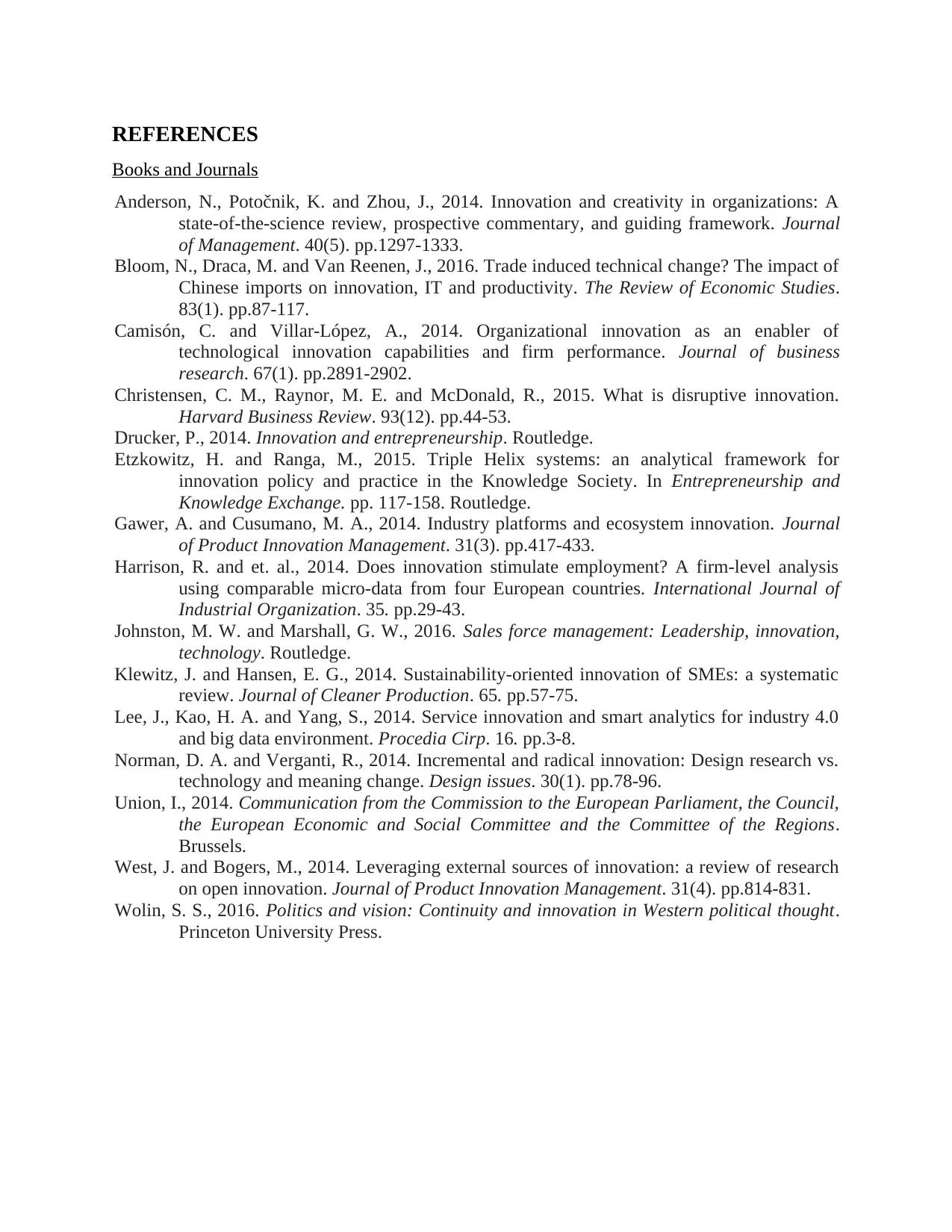
REFERENCES
Books and Journals
Anderson, N., Potočnik, K. and Zhou, J., 2014. Innovation and creativity in organizations: A
state-of-the-science review, prospective commentary, and guiding framework. Journal
of Management. 40(5). pp.1297-1333.
Bloom, N., Draca, M. and Van Reenen, J., 2016. Trade induced technical change? The impact of
Chinese imports on innovation, IT and productivity. The Review of Economic Studies.
83(1). pp.87-117.
Camisón, C. and Villar-López, A., 2014. Organizational innovation as an enabler of
technological innovation capabilities and firm performance. Journal of business
research. 67(1). pp.2891-2902.
Christensen, C. M., Raynor, M. E. and McDonald, R., 2015. What is disruptive innovation.
Harvard Business Review. 93(12). pp.44-53.
Drucker, P., 2014. Innovation and entrepreneurship. Routledge.
Etzkowitz, H. and Ranga, M., 2015. Triple Helix systems: an analytical framework for
innovation policy and practice in the Knowledge Society. In Entrepreneurship and
Knowledge Exchange. pp. 117-158. Routledge.
Gawer, A. and Cusumano, M. A., 2014. Industry platforms and ecosystem innovation. Journal
of Product Innovation Management. 31(3). pp.417-433.
Harrison, R. and et. al., 2014. Does innovation stimulate employment? A firm-level analysis
using comparable micro-data from four European countries. International Journal of
Industrial Organization. 35. pp.29-43.
Johnston, M. W. and Marshall, G. W., 2016. Sales force management: Leadership, innovation,
technology. Routledge.
Klewitz, J. and Hansen, E. G., 2014. Sustainability-oriented innovation of SMEs: a systematic
review. Journal of Cleaner Production. 65. pp.57-75.
Lee, J., Kao, H. A. and Yang, S., 2014. Service innovation and smart analytics for industry 4.0
and big data environment. Procedia Cirp. 16. pp.3-8.
Norman, D. A. and Verganti, R., 2014. Incremental and radical innovation: Design research vs.
technology and meaning change. Design issues. 30(1). pp.78-96.
Union, I., 2014. Communication from the Commission to the European Parliament, the Council,
the European Economic and Social Committee and the Committee of the Regions.
Brussels.
West, J. and Bogers, M., 2014. Leveraging external sources of innovation: a review of research
on open innovation. Journal of Product Innovation Management. 31(4). pp.814-831.
Wolin, S. S., 2016. Politics and vision: Continuity and innovation in Western political thought.
Princeton University Press.
Books and Journals
Anderson, N., Potočnik, K. and Zhou, J., 2014. Innovation and creativity in organizations: A
state-of-the-science review, prospective commentary, and guiding framework. Journal
of Management. 40(5). pp.1297-1333.
Bloom, N., Draca, M. and Van Reenen, J., 2016. Trade induced technical change? The impact of
Chinese imports on innovation, IT and productivity. The Review of Economic Studies.
83(1). pp.87-117.
Camisón, C. and Villar-López, A., 2014. Organizational innovation as an enabler of
technological innovation capabilities and firm performance. Journal of business
research. 67(1). pp.2891-2902.
Christensen, C. M., Raynor, M. E. and McDonald, R., 2015. What is disruptive innovation.
Harvard Business Review. 93(12). pp.44-53.
Drucker, P., 2014. Innovation and entrepreneurship. Routledge.
Etzkowitz, H. and Ranga, M., 2015. Triple Helix systems: an analytical framework for
innovation policy and practice in the Knowledge Society. In Entrepreneurship and
Knowledge Exchange. pp. 117-158. Routledge.
Gawer, A. and Cusumano, M. A., 2014. Industry platforms and ecosystem innovation. Journal
of Product Innovation Management. 31(3). pp.417-433.
Harrison, R. and et. al., 2014. Does innovation stimulate employment? A firm-level analysis
using comparable micro-data from four European countries. International Journal of
Industrial Organization. 35. pp.29-43.
Johnston, M. W. and Marshall, G. W., 2016. Sales force management: Leadership, innovation,
technology. Routledge.
Klewitz, J. and Hansen, E. G., 2014. Sustainability-oriented innovation of SMEs: a systematic
review. Journal of Cleaner Production. 65. pp.57-75.
Lee, J., Kao, H. A. and Yang, S., 2014. Service innovation and smart analytics for industry 4.0
and big data environment. Procedia Cirp. 16. pp.3-8.
Norman, D. A. and Verganti, R., 2014. Incremental and radical innovation: Design research vs.
technology and meaning change. Design issues. 30(1). pp.78-96.
Union, I., 2014. Communication from the Commission to the European Parliament, the Council,
the European Economic and Social Committee and the Committee of the Regions.
Brussels.
West, J. and Bogers, M., 2014. Leveraging external sources of innovation: a review of research
on open innovation. Journal of Product Innovation Management. 31(4). pp.814-831.
Wolin, S. S., 2016. Politics and vision: Continuity and innovation in Western political thought.
Princeton University Press.
⊘ This is a preview!⊘
Do you want full access?
Subscribe today to unlock all pages.

Trusted by 1+ million students worldwide
1 out of 12
Related Documents
Your All-in-One AI-Powered Toolkit for Academic Success.
+13062052269
info@desklib.com
Available 24*7 on WhatsApp / Email
![[object Object]](/_next/static/media/star-bottom.7253800d.svg)
Unlock your academic potential
Copyright © 2020–2025 A2Z Services. All Rights Reserved. Developed and managed by ZUCOL.





